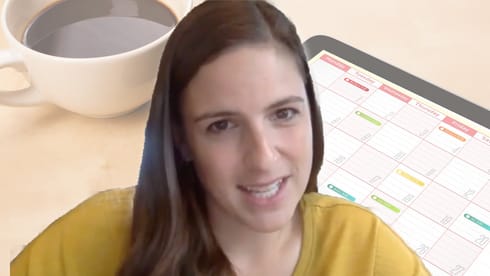What classical homeschooling looks like in our home
What your homeschool looks like, even as you try working toward classical education principles, depends on where you’ve been, and how and when you entered this path.
There are no gate-keepers checking your credentials and only letting you in if you use the approved materials. And that’s a good thing. This week, we’re going to be sharing how these principles play out in our homes. We’re all different, and I hope that will encourage you.
My husband and I were both homeschooled, and now it’s our turn to homeschool our crew. Neither my husband or I have ever gone to public school (at least, not until community college and university). That puts us at a huge advantage for weaving education into life, because our parents did the hard work of de-schooling their approach. I don’t remember what class it was for or why I picked the topic, but in college I ended up writing a research paper on classical education in a homeschool setting.
I interviewed a teacher at Logos School who homeschooled his own children, and that conversation made me realize I had no idea what I was stepping into. I wrote the paper, but it only left me feeling completely ignorant about the topic. That was not acceptable, so from then on, before my husband and I were even married, I was a classical education research hobbyist. I found Cindy Rollins when my oldest was a toddler and read Norms and Nobility, Leisure, the Basis of Culture, and Poetic Knowledge with her online book clubs before we ever started “real school” (in my mind, that’s third grade).
Finding myself with actual small children of my own, I repented of my early-twenties’ arrogance that my mom’s “better late than early” Moore-inspired approach was lacking and lazy. A year or two into Morning Time and Math-U-See and read-alouds, we repented of our early-twenties’ attempt to launch an ACCS classical school. I was not going to give up this amazing life of learning alongside my children, exhausting and demanding as it was.
So, what does it look like to actually put these principles we’ve been talking about into practice? What do these principles look like with real people in a real home?
It looks different in every family, but here’s what it looks like in ours.
Virtue as the Goal
One of my favorite quotes on education is by David Hicks in Norms and Nobility when he writes:
The purpose of education is not the assimilation of facts or the retention of information, but the habituation of the mind and body to will and to act in accordance with what one knows.
So we need to grow in our knowing, but we need to conform our doing as well. We need to do what we know is right. Then we need to learn more and more what right, what Truth, is. Then put it into practice. Again and again. Over and over.
The one thing I try to remind myself of every morning, one thing I pray continually for grace to live out, is to see the bumpy patches of our day as opportunities for growth in virtue rather than as evidence of condemnation.
When a child cries over math, the problem isn’t the child or the math and the point isn’t that we’re failing. The point is, “Will you glorify God in how you treat this child right now? in how you treat God’s creation expressed in math right now? in how you rely on God’s grace to pull you through rather than your own willpower?”
Ideas as Soul Formation
When we choose to read an interesting biography over a textbook, memorize an entire Psalm rather than an out-of-context verse, or bring our nature notebooks when we go camping rather than do a science experiment from a book, we are favoring ideas over facts.
We still memorize facts. We learn the presidents, the books of the Bible, the genealogy of Christ. We even memorize (or, at least, repeat many times) a handful of history sentences pulled from our timeline figures.
This year we’re even learning the periodic table in order with a song! But it’s not a disjointed, out-of-context memorization of bare facts. The song will come in the context of reading about elements, about the history of the periodic table, about atoms and electrons – it will come in context, adding a fun and upbeat tone to our time together and cementing in what we’re reading.
Beauty as Home
One powerful way to teach through atmosphere and the beauty of our homes is to knock down the barriers between “real life” and “learning.” We can do this in many ways, but one way we do that in our house is by having no reserved spaces for school.
Of course there are reserved places for the stuff: A home for everything and everything in its home and all that. But the reading can happen in the living room, at the bar of the kitchen, sprawled on the playroom floor, in bed, outside in a hammock – anywhere. Conversations that happen during dinner prep or car rides are as educational as the orchestrated narration. Is that drawing lesson copied from the art book schoolwork or free time? Hard to say. Does it matter?
Take advantage of doing education at home to let it bleed into life; let the edges blur and find beauty in a full life lived together.
Imitation as Learning Style
Rather than thinking of myself as a teacher and what I do as teaching, I prefer to think of it as tutoring and discipleship: this keeps the focus small, on the individuals I’m teaching and our relationship. It’s alarming but true: the kids are learning more from the way I handle life not going my way than they do from their books and assignments. So how I manage throughout the day and how I treat them and speak to them matters far more than anything else. When I notice the habit of complaining or laziness creeping in, I can always see that it actually started with me: my children are mirrors, magnifying glasses, who follow my lead and express the same responses in less socially adept ways.
So I have to own the attitude problems and fix my own always and first.
Poetic Knowledge as Curriculum
What is learning? Does it have to be measured on a multiple-choice choice to count?
No.
Learning is
- helping with chores
- swimming with friends
- drawing for fun
- writing a comic book
- playing ball with a baby sister
- helping mom with dinner
- reading a stack of library books
- chatting with a friend about Minecraft
- playing Legos with friends and siblings from 4 years old to 12 years old
- helping set up chairs and tables alongside the men at church
- playing a board game with Dad
And all that not because a fraction was used in the process, but because living a full life in relationship with others is a huge part of the training required to grow into maturity, into virtue.
Yes, learning is acing the math test, diagramming a sentence, or conjugating the Latin verb. But those tasks on the checklist are only a partial picture, and as the orchestrators of the entire upbringing of our children, we need to remember the complete picture that cannot be measured analytically.
Homeschooling classically is not being perfect or feeling successful, but continuing in faithfulness and love – both we and our children with us.


